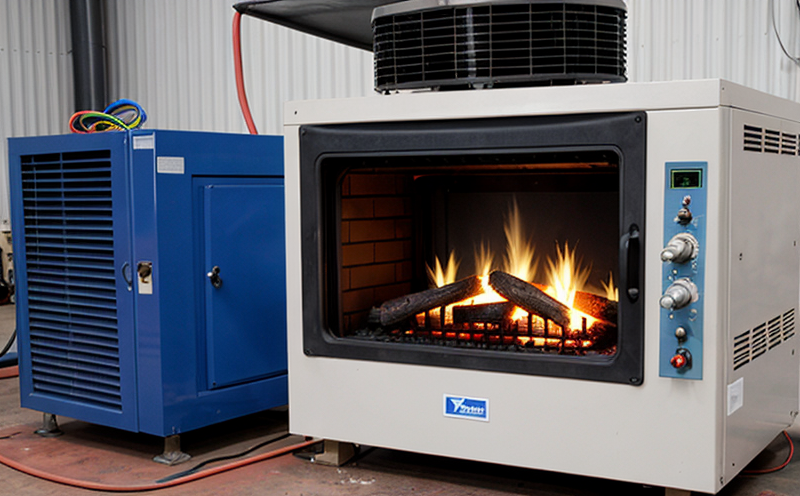IEC 60068 2 14 Thermal Shock Testing for Lighting Devices
The IEC 60068-2-14 standard specifies the procedures and conditions under which thermal shock testing should be conducted, with a specific focus on lighting devices. This test evaluates the ability of lighting fixtures to withstand rapid temperature changes without compromising their performance or integrity. The purpose is to ensure that these devices can operate reliably in environments where extreme temperatures fluctuate frequently.
Thermal shock testing is crucial for quality assurance and compliance within the lighting sector, especially when dealing with devices exposed to harsh environmental conditions such as industrial settings, outdoor installations, and regions with significant temperature variations. Compliance with this standard helps manufacturers meet international quality and safety standards, thereby enhancing consumer trust and product reliability.
The test involves exposing the lighting device to a series of temperature cycles within a controlled environment. Typically, these devices are subjected to rapid heating from one extreme temperature (e.g., -20°C) to another (e.g., +70°C), or vice versa, in predetermined intervals. This process simulates real-world scenarios where the lighting fixture may experience such drastic changes due to external factors like sun exposure and ambient temperature fluctuations.
For accurate testing, it is essential that the specimen preparation aligns with specified guidelines laid out by IEC 60068-2-14. This includes ensuring that all components are properly assembled before being subjected to thermal cycling. The apparatus used for this test must be capable of achieving and maintaining these extreme temperatures accurately.
| Parameter | Description |
|---|---|
| Temperature Range | -40°C to +85°C, though other ranges may be specified depending on the application. |
| Cycle Duration | Each cycle typically lasts from 1 hour to several hours, depending on the device type and its expected operating environment. |
| Number of Cycles | A minimum of five cycles is recommended; however, more may be required based on specific product requirements. |
The acceptance criteria for this test are stringent. Devices must not show signs of mechanical damage or electrical failure during or after the thermal shock testing process. Additionally, performance parameters such as luminous flux and color temperature should remain within acceptable limits throughout these tests.
Understanding the importance of IEC 60068-2-14 thermal shock testing allows quality managers, compliance officers, R&D engineers, and procurement teams to make informed decisions regarding product design and manufacturing processes. By adhering to this standard, manufacturers can ensure their lighting devices meet global standards for reliability and safety.
Why It Matters
The significance of IEC 60068-2-14 thermal shock testing extends beyond mere compliance; it plays a pivotal role in safeguarding both human health and environmental sustainability. Lighting devices that fail to withstand temperature extremes could lead to malfunctions or even catastrophic failures, potentially endangering users and causing significant economic losses.
From an environmental perspective, reliable lighting fixtures contribute positively to energy efficiency initiatives by ensuring continuous operation without interruptions due to component failures. This not only reduces maintenance costs but also promotes responsible use of resources.
- Enhanced Reliability: Ensures consistent performance across diverse operating conditions.
- Safety Assurance: Prevents potential hazards associated with non-functioning lighting systems.
- Economic Efficiency: Minimizes downtime and repair expenses through robust design.
In summary, implementing IEC 60068-2-14 thermal shock testing demonstrates a commitment to quality assurance that benefits all stakeholders involved in the lighting industry.
Scope and Methodology
| Parameter | Description |
|---|---|
| Environmental Conditions | The test must be conducted in a controlled environment capable of reaching temperatures ranging from -40°C to +85°C. |
| Specimen Preparation | All components should be fully assembled and wired before undergoing thermal cycling. |
| Type of Cycles | The test involves rapid transitions between high and low temperatures as specified in the standard. |
| Step | Description |
|---|---|
| Set Up | The specimen is placed in the temperature chamber and preheated to the initial test temperature. |
| Cycling Process | The device undergoes rapid heating from one extreme temperature to another, followed by cooling back to the starting point. |
| Monitoring | Data points are recorded throughout each cycle for analysis post-testing. |
These detailed procedures ensure that every lighting device undergoes rigorous testing conditions reflective of real-world scenarios. Compliance with these stringent requirements guarantees high-quality products capable of enduring challenging environments without degradation.
Industry Applications
- Outdoor Lighting: Devices used in public spaces, traffic signals, and street lighting must withstand wide temperature swings throughout the day.
- Industrial Environments: Facilities with varying temperatures due to industrial processes benefit from reliable lighting fixtures that can operate consistently under these conditions.
- Ocean Front Installations: Coastal areas experience significant daily temperature changes, making it critical for manufacturers to produce robust lighting solutions.
In addition to these specific applications, IEC 60068-2-14 thermal shock testing ensures that lighting devices perform reliably in any environment where rapid temperature variations are expected. This includes temporary installations such as event venues and construction sites.
| Type of Installation | Description |
|---|---|
| Outdoor Lighting | Includes street lights, traffic signals, and public area lighting systems exposed to wide temperature fluctuations. |
| Industrial Environments | Facilities where the ambient temperature changes due to industrial processes require reliable lighting solutions. |
| Ocean Front Installations | Critical for coastal areas experiencing significant daily temperature variations, ensuring consistent performance in harsh conditions. |
The versatility of IEC 60068-2-14 thermal shock testing makes it indispensable across various sectors. Its ability to simulate real-world conditions ensures that lighting devices are not only compliant with international standards but also capable of enduring diverse operational environments reliably.





